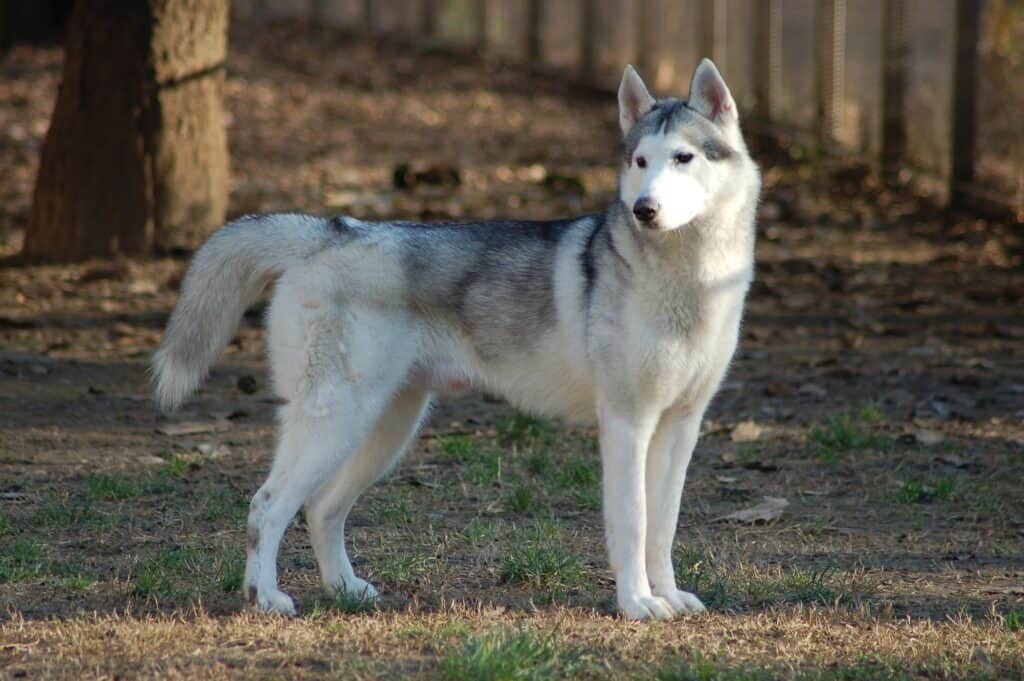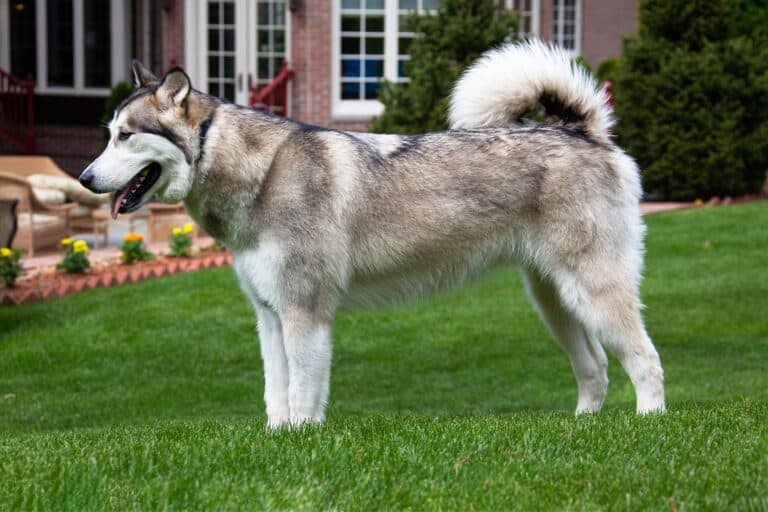Purpose
The Alaskan Malamute is one of the few breeds that is very close to its original type and purpose. It still functions both as a working dog and as a companion dog.
Over the centuries, the emphasis has changed from working to companion dog, but as the breed associations would like to emphasise, the original purpose of the Malamute should never be forgotten and the breed’s versatile working qualities should be encouraged.
Temperament & Behaviour
The Alaskan Malamute is friendly to people and open to strangers, so it is not just a ‘one-man dog’. It is a loyal and devoted companion, playful when excited, but usually impressively dignified when grown up. It is not really a watchdog, but its natural curiosity makes it alert to its surroundings and, guided by its strong herding instinct, it warns of approaching threats.
Alaskan Malamutes lack the typical desire to please that service dogs have. They are independent and largely guided by their instincts. They have a strong sense of pack hierarchy and tend to move up the pack hierarchy as high as possible. They know how to exploit their owner’s weaknesses and may test their limits constantly.
Because of their pack mentality, hostility towards other dogs (especially of the same sex) is quite common in the breed and can even lead some Malamutes to behave in an openly aggressive manner towards other male dogs.
Alaskan Malamutes should be outgoing and show a high level of activity and enthusiasm. They are easily provoked to play and are also very clever. Malamutes are not difficult to train, but they quickly lose interest with repetition of exercises and maintaining motivation requires a sense of humour and ingenuity on the part of the trainer.
Their independence has sometimes been mistaken for stupidity, but it is this very trait that has enabled them to survive in cold and demanding conditions for generations.
The Malamute is by breed definition an Arctic heavy-duty sled dog. In order to perform the typical tasks of the breed, it requires tenacity, self-confidence and resilience. These things, combined with the dog’s energy and strong will, are part of the Alaskan Malamute’s character.
Health
The Alaskan Malamute is generally a healthy and relatively long-lived breed, often remaining in good health in old age.
Grooming
The Malamute is relatively easy to care for, the coat is simply washed when necessary, for example in summer, and brushed regularly.
What Kind Of Person Is The Alaskan Malamute Suited For?
The breed is suitable for an active person or family who enjoys nature and exercise.
Dog Breeds Similar To Alaskan Malamute

There are some dog breeds out there that share some similarities with the Alaskan Malamute. Next we will take a look at some of those breeds and discuss how they are similar to (and different from) the Alaskan Malamute.
Whether you are considering adding a Malamute to your family or are just curious about other similar breeds, this post is for you!
1. Siberian Husky

- AKC Group: Working Group
- FCI Group: Spitz & Primitive Types
- FCI Section: Nordic Sledge Dogs
| Breed | Energy Level | Exercise Need | Playfulness | Affection Level | Friendliness (Dogs) | Friendliness (Other Pets) | Friendliness (Strangers) | Ease of Training | Watchdog Ability | Protection Ability | Grooming Need | Cold Tolerance | Heat Tolerance |
|---|---|---|---|---|---|---|---|---|---|---|---|---|---|
| Siberian Husky |
First similar breed on our list is the Siberian Husky, which often gets mistaken for the Alaskan Malamute.
The Siberian Husky is a medium to large sized working dog breed that originates from Siberia. The breed was originally used for sledding, hunting and herding in the cold climates of Siberia.
The Siberian Husky is a descendant of the Chukchi dogs of northeastern Asia. They were bred by the Chukchi people for sledding, hunting, and herding in the cold climates of Siberia.
Personality
The Siberian Husky is an intelligent and active breed of dog. They are friendly and outgoing, but can also be independent and stubborn. Like the Alaskan Malamute, they require firm training and socialisation from an early age.
Siberian Huskies are also active dogs that need a lot of exercise. They love to run and play and will do best in homes with large yards or access to open spaces.
While Siberian Huskies make great sled dogs, they can also be good jogging and hiking companions. They are devoted to their families and get along well with others as long as they have adequate exercise.
If left unchecked, a Siberian Husky’s high energy level and independence can result in some unwanted behaviours, such as excessive barking, digging, and chewing.
Physical Features
Just like the Alaskan Malamute, Siberian Huskies have a thick coat of fur that protects them from the cold weather. It also has a similar wolf-like appearance.
However, Siberian Huskies typically have blue or multi-colored eyes, whereas Alaskan Malamutes usually have brown eyes.
Siberian Huskies also tend to be smaller in size than Alaskan Malamutes. They typically weigh between 35 and 60 pounds and stand 20 to 24 inches tall at the shoulder. In comparison, Alaskan Malamutes typically weigh between 75 and 100 pounds and stand 23 to 28 inches tall at the shoulder.
2. Alaskan Husky

The Alaskan Husky is a mixed breed of dog that originates from Alaska. The breed was originally developed for sledding and racing in the cold climates of Alaska.
Alaskan Huskies are a mix of different dogs, but they are typically sledding dogs or working dogs. The most common breeds used in their development are the Siberian Husky, Alaskan Malamute, and Greenland Dog.
Personality
Alaskan Huskies are intelligent and active dogs that require a lot of exercise. They are friendly and outgoing, but can also be independent and stubborn. Like the Alaskan Malamute, they require firm training and socialisation from an early age.
Physical Features
Alaskan Huskies have a thick coat of fur that protects them from the cold weather. They also have a similar wolf-like appearance. However, they can come in a variety of colors and patterns.
Alaskan Huskies typically weigh between 35 and 75 pounds and stand 20 to 26 inches tall at the shoulder, which make them smaller than Alaskan Malamutes.
While Alaskan Huskies are not as common as other dog breeds, they make great pets for active families.
3. Samoyed

- AKC Group: Working Group
- FCI Group: Spitz & Primitive Types
- FCI Section: 5.1 Nordic Sledge Dogs
| Breed | Energy Level | Exercise Need | Playfulness | Affection Level | Friendliness (Dogs) | Friendliness (Other Pets) | Friendliness (Strangers) | Ease of Training | Watchdog Ability | Protection Ability | Grooming Need | Cold Tolerance | Heat Tolerance |
|---|---|---|---|---|---|---|---|---|---|---|---|---|---|
| Samoyed |
The Samoyed is a medium sized working dog breed that originates from Siberia. It is is a descendant of the Nenets herding dogs which were originally used for reindeer herding in the cold climates.
Personality
The Samoyed is a friendly, energetic, curious, clever and even stubborn dog breed. They tend to remain playful throughout their lives.
The Samoyed is similar to the Alaskan Malamute in many ways including their friendly, energetic and curious personalities. However, the Samoyed is not as independent and stubborn as the Alaskan Malamute.
In terms of exercise, both the Samoyed and Alaskan Malamute need plenty of activity to stay happy and healthy.
Physical Features
Being smaller and lighter the Samoyed does not resemble Alaskan Malamute too much. It also differs in coat: Samoyeds only come in white coats.
4. American Akita

- AKC Group: Working Group
- FCI Group: Spitz & Primitive Types
- FCI Section: Asian Spitz and related breeds
| Breed | Energy Level | Exercise Need | Playfulness | Affection Level | Friendliness (Dogs) | Friendliness (Other Pets) | Friendliness (Strangers) | Ease of Training | Watchdog Ability | Protection Ability | Grooming Need | Cold Tolerance | Heat Tolerance |
|---|---|---|---|---|---|---|---|---|---|---|---|---|---|
| American Akita |
The American Akita is a large working dog breed that originates from Japan. It was originally bred for hunting, but later became popular as a guard dog and companion dog.
Personality
The American Akita is a strong, independent and loyal dog breed. They are intelligent and have a lot of energy. American Akitas need plenty of exercise and training to stay happy and balanced.
The American Akita is similar to the Alaskan Malamute in many ways including their independent, loyal and energetic personalities. However, the American Akita is not as stubborn as the Alaskan Malamute.
In terms of exercise, both the American Akita and Alaskan Malamute need plenty of activity to stay happy and healthy.
Physical Features
The American Akita is a large dog breed that can weigh up to 130 pounds. This means that they are even larger than Alaskan Malamutes. However, they have similar coat that comes in a variety of colors including white, brindle and pinto.
5. Japanese Akita Inu

- AKC Group: Foundation Stock Service
- FCI Group: Spitz & Primitive Types
- FCI Section: 5.5 Asian Spitz and related breeds
The Japanese Akita Inu is a large working dog breed that originates from Japan. It was originally bred for hunting, but later became popular as a guard dog and companion dog.
The Japanese Akita Inu is a strong, independent and loyal dog breed. They are intelligent and have a lot of energy. Japanese Akitas need plenty of exercise and training to stay happy and balanced.




